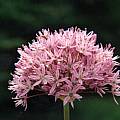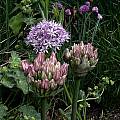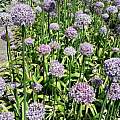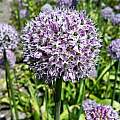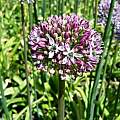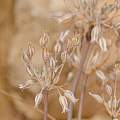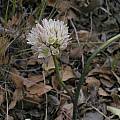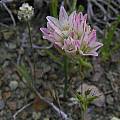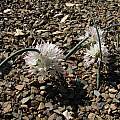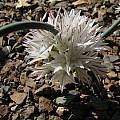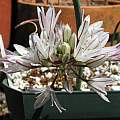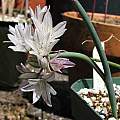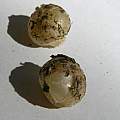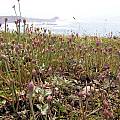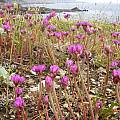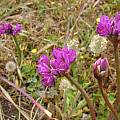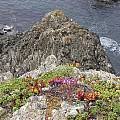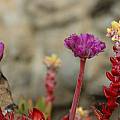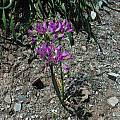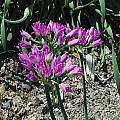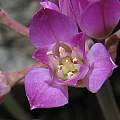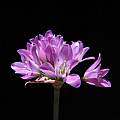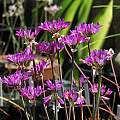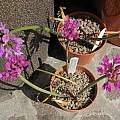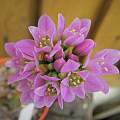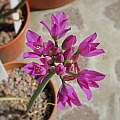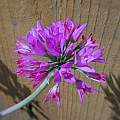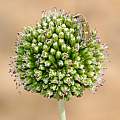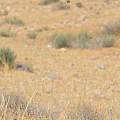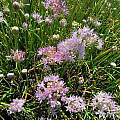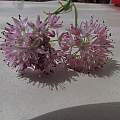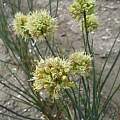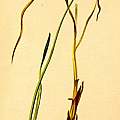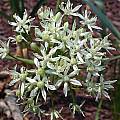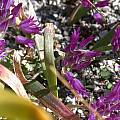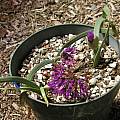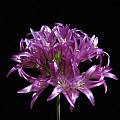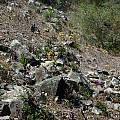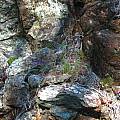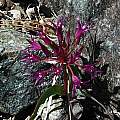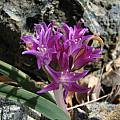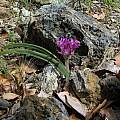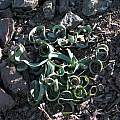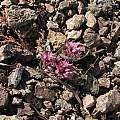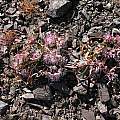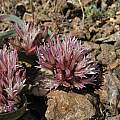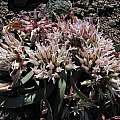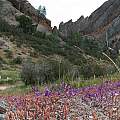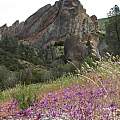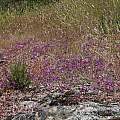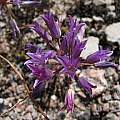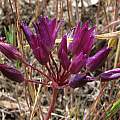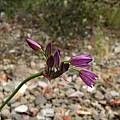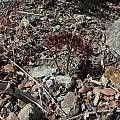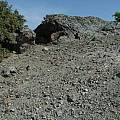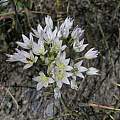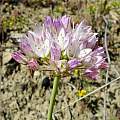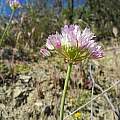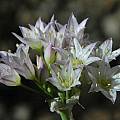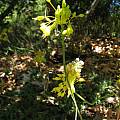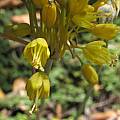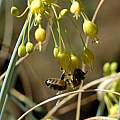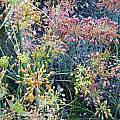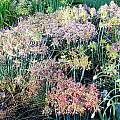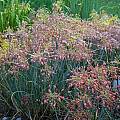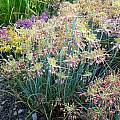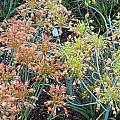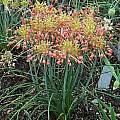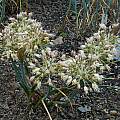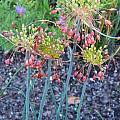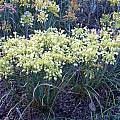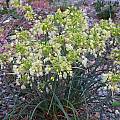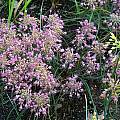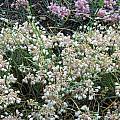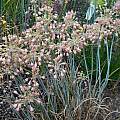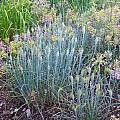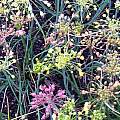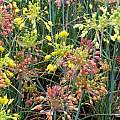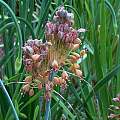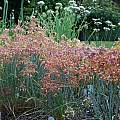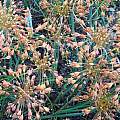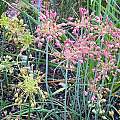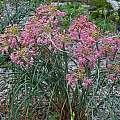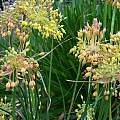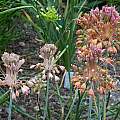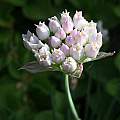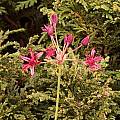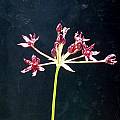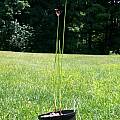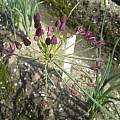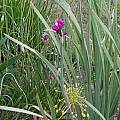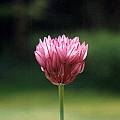This page compiles all the information and photos of the Allium taxa, cultivars, and hybrids we currently have on the PBS wiki. The Allium index gives information about the genus and includes tables of species and hybrids and cultivars.
Page 1: A. Globemaster... Page 2: A. atropurpureum... Page 3: A. carmeli... Page 5: A. guttatum... Page 6: A. karataviense... Page 7: A. membranaceum... Page 8: A. paradoxum... Page 9: A. regelii... Page 10: A. serra... Page 11: A. tardiflorum... Page 12: A. vineale...
Allium decipiens Fisch. ex Schult. & Schult.f. ranges from eastern Europe to Siberia and northern Turkey. It has glossy green lorate leaves held close to the ground, and tall stems to 3' (90 cm) with lovely domed clusters of pink to lilac starry blooms. The second photo shows the pink form of Allium nigrum L. in early anthesis and a single Allium decipiens bloom just behind. The first two photos by Mark McDonough and the last three by Wietse Mellema.
Allium desertorum Forssk.is a species native to Israel. Photo by Gideon Pisanty.
Allium diabolense (Ownbey & Aase ex Traub) McNeal (syn. Allium fimbriatum var. diabolense Ownbey & Aase) is a California species found south of San Francisco Bay in the Inner South Coast ranges where it is often found growing in serpentine. It has white flowers with pink midveins and one leaf. Photos 1-2 were taken by Mary Sue Ittner of plants growing on Figueroa Mountain in Santa Barbara County.
The photos below were taken by Nhu Nguyen of plants in cultivation. Photos 1-2 were taken at the UC Botanical Garden.
Allium dichlamydeum E. Greene grows near the coast in Northern and central California. The inflorescence is medium pink. The Flora of North America describes the bulbs as having a herringbone pattern. See the Flora's description of Allium dichlamydeum. The herring bulb pattern is on the bulb coat and this is often partly or completely missing if the bulb is dug up. The underlying bulb is white. Therefore the zigzag/herringbone pattern may not be readily apparent and in any case is more easily visible with a hand lens. Photo of bulbs by Ken Gilliland.
Since they grow on cliff faces where there is little soil, their bulbs do not bury very deep. It is one of the latest blooming of the Californian onions. These pictures by Bob Rutemoeller show it growing on the Mendocino Sonoma Coast in bud on a coastal bluff, in bloom in the same spot a few weeks later, and a close-up. The fourth picture shows it growing in a wild rock garden where it would be difficult for predators to get it, and almost two months after the first pictures in mid July 2003 it is still in bloom, now with Dudleya farinosa (Lindl.) Britton & Rose blooming at the same time. The final picture is a close-up of the two plants in bloom in another year.
Photo 1 below shows the plants growing in a raised bed in Mary Sue Ittner's garden. Photos 2-3 by Mark McDonough show two views of this species growing in his Massachusetts garden. Photos 4-6 were taken by Nhu Nguyen of plants growing in a small pot in California. The bulbs divide well and produces a wonderful show.
Photos below by RH. Photos three and four originally obtained as Allium falcifolium Hook & Arn. Photo four shows flowers going over and becoming pointier as they wilt, this had created some confusion for the grower.
Allium dictyoprasum C.A.Mey. ex Kunth is a tall, small flowered species from Israel. Photos by Gideon Pisanty.
Allium douglasii Hook. is native to Washington and northeastern Oregon. This variable species prefers vernally wet soil in shallow depression or moist slopes. Photos by Richard Haard.
Allium ericetorum Thore is a species native to mountainous areas surrounding the Mediterranean. It grows to roughly 50 cm, with a round scape. Photo by Wietse Mellema. Illustration from the Atlas der Alpenflora, 1882.
Allium eulae Corey ex T.M.Howard (synonym A. fraseri var. eulae (Ownbey) Shinners), is native to Texas where it is endemic to the Texas Highland Lake region, growing in seepy places, although hardy in more northern climates and growing well in normal well drained garden soil in full sun. Photo by John Lonsdale.
Allium falcifolium Hook. & Arn. occurs on serpentine soils and outcrops from San Francisco Bay to Oregon. It is often found on slopes with excellent drainage. It is also never found too far away from oak trees, relying on the organic matter from decaying oak leaves. The hummus contents can range from 50% - 20% in the wild. There are two flower forms of this species, with the more common magenta pictured below and a more rare and often elusive white form. 1st photo by Jane McGary, 2nd by Mary Sue Ittner, and the last a macro of a specimen grown by Nhu Nguyen.
Habitat photos from Nhu Nguyen are shown below. Photos 1-2 shows the habitat in Napa County where they flower with Eschscholzia caespitosa Benth. amongst the serpentine rocks. Photo 5 illustrates the sickle shaped leaves.
The photos below of a white/pink form were taken by Nhu Nguyen on Mount Diablo in Contra Costa County, CA. This form interestingly does not grow on serpentine. Photo 1 shows wonderfully curly leaves.
Allium fimbriatum S.Watson is restricted to California where it grows on dry, well-drained slopes. There are three varieties of the species accepted by the Jepson Manual and Flora of North America. A fourth, listed in Plants of the World Online, Allium fimbriatum var. denticulatum Ownbey & Aase ex Traub is considered by the Jepson Manual to be a synonym of Allium denticulatum (Traub) McNeal
Allium fimbriatum var. fimbriatum is distributed in California to Baja Mexico. It has rose purple flowers with flaring tips. It grows in gravelly volcanic or serpentine clays. The photos below were taken by Nhu Nguyen in Pinnacles National Park.
Allium fimbriatum var. mohavense Jeps. is only found in the Mohave Desert. It has flowers that are white to pink to light lavender.
Allium fimbriatum var. purdyi (Eastw.) Ownbey ex McNeal is restricted to serpentine soil in the inner North Coast ranges (Colusa, Glenn, Lake, Napa counties). Flowers are white to pale lavender with darker midveins. The first three photos were taken by Nhu Nguyen. The second photo shows developing into seeds and the third photo shows a serpentine slope where they occur.
Photos below were taken by Mary Sue Ittner. The first three were taken along Bear Valley Road in April different years. They were growing along the bank next to the road. The last shows flowers of plants grown from seed collected in Lake Co. at 2150' in crumbly, flaky serpentine talus flats.
Allium flavum L. is native to the Mediterranean. It is one of the species which has been selected for numerous color forms as seen in the entries below. The first two photos below were taken by Nhu Nguyen at the UC Botanical Garden in August 2008. The particular accession was collected from France. It grows under the shades of oak trees where it gets filtered sunlight. The next two photos from Mary Sue Ittner, including one with a pollinator.
Allium flavum ssp. tauricum (Besser ex Rchb.) K.Richt. (syn. Allium paczoskianum Tuzson) "selected mixed colors" photo taken July 8, 2002 followed by "Selected mixed colors in the morning". You have to love these things; the colors are so lovely, refreshing, and variable. Due to their pastel flower colors, and the fact the florets are waxy and have an underlying color, then covered with a dusty "bloom" or powder of another color on the outside, the color rendition is hard to characterize and each looks very different depending on light and time of day. I particularly like to observe them in the low morning light. Notice too, the wide, boat-shaped spathe valves that mix in with the flower heads, more pronounced on some specimens than others. Photos by Mark McDonough.
Named Color Forms - The following list represents a sampling of named color forms that I selected over the past several years. All photos by Mark McDonough.
The first two photos below are of 'Boston Baked Beans' and the third shows 'Cantaloupe' and 'Tan'. The fourth photo is of 'Cinnamon' - one of my favorite colors, and the first to be selected in the deep orange range. The color changes over it's bloom cycle, but in general could be characterized as a burnt brownish or burnt reddish-orange. As with most "tauricums", the growth is compact and stocky, typically 8"-10" (20-25 cm) in height, clumping well, and with gray or silvered foliage, the silver patina most evident on the stems.
The first two photos show 'Drawn Butter' and 'Hot Cauldron 1'. The third photo is of 'Hot Molasses' followed by two of 'Lemon Cooler' the latter is one of the more lively colored selections I made in summer 2001 with orangy-yellow and pink flowers. There was a "Hot Cauldron 2" selected as well. I believe both were lost over winter due to rodent predation, but I did save seed. In the foreground is a dwarf, deep pink form just "going over".
Photos of 'Lindsey', 'Pastel Parasol', 'Silver Shrimp', and 'Truely Faded', the last in bud, showing the striking silver coloration of stems and spathes.
Unnamed Color Forms - The following list show yet more variation in flower color and plant form. All photos by Mark McDonough.
First mixed colors, 2 yr. old seedlings, then 3 yr old seedlings, an orange form at late anthesis, ageing to rose, and orange and pink forms from a squirrel's eye view.
Photos below illustrate orange, pastel two-toned yellow and orange form and pink, a light yet lively form with blue-white stems, a robust wiry-leafed form with bright pink flowers, tawny pastels in pale melon colors, and white-aging-pinkish, and an orange-aging-rose form.
Allium geyeri S.Watson is native to Pacific coast North West America damp meadows. Named for the German botanist Charles A. Geyer who travelled across the Western USA in 1843. Photograph by Rimmer de Vries.
Allium glandulosum Link & Otto is a Mexican species that blooms in late summer and autumn with dark, metallic red flowers. The plant shown here in the first three photos from Mark McDonough was originally collected in central Mexico at high elevation in swampy soil. It was difficult to photograph well. The first two show the true red flowers close up, the third an entire potted plant. The last photo by Wietse Mellema.
Allium gooddingii Ownbey - another of the moisture-loving western species, this one from Arizona and New Mexico, growing at high elevation swampy or marshy spots, or alongside streams. It's a slender plant, with a few-flowered upright spray of intense red-purple flowers. The gray stems reach about 18" (45 cm). In the photo we see the gray foliage of A. plummerae S.Watson in back and a flower head of A. flavum L. Photo by Mark McDonough.
Allium griffithianum Boiss. - a beauty from C. Asia, with upright, flat-topped drumsticks of large carnous red-rose flowers, showing conspicuous dark red stripping. Allied to A. jacquemontii Kunth., Allium griffithianum only stayed with me a couple years, then succumbed (bulb rotted, I think). Photo by Mark McDonough.
Page 1: A. Globemaster... Page 2: A. atropurpureum... Page 3: A. carmeli... Page 5: A. guttatum... Page 6: A. karataviense... Page 7: A. membranaceum... Page 8: A. paradoxum... Page 9: A. regelii... Page 10: A. serra... Page 11: A. tardiflorum... Page 12: A. vineale...
Allium index - Allium flavum Relatives - American alliums A-F - American alliums G-Z - Big Ball alliums - Blue alliums - Chives - Domed alliums - Drumstick alliums - Rhizomatous alliums
